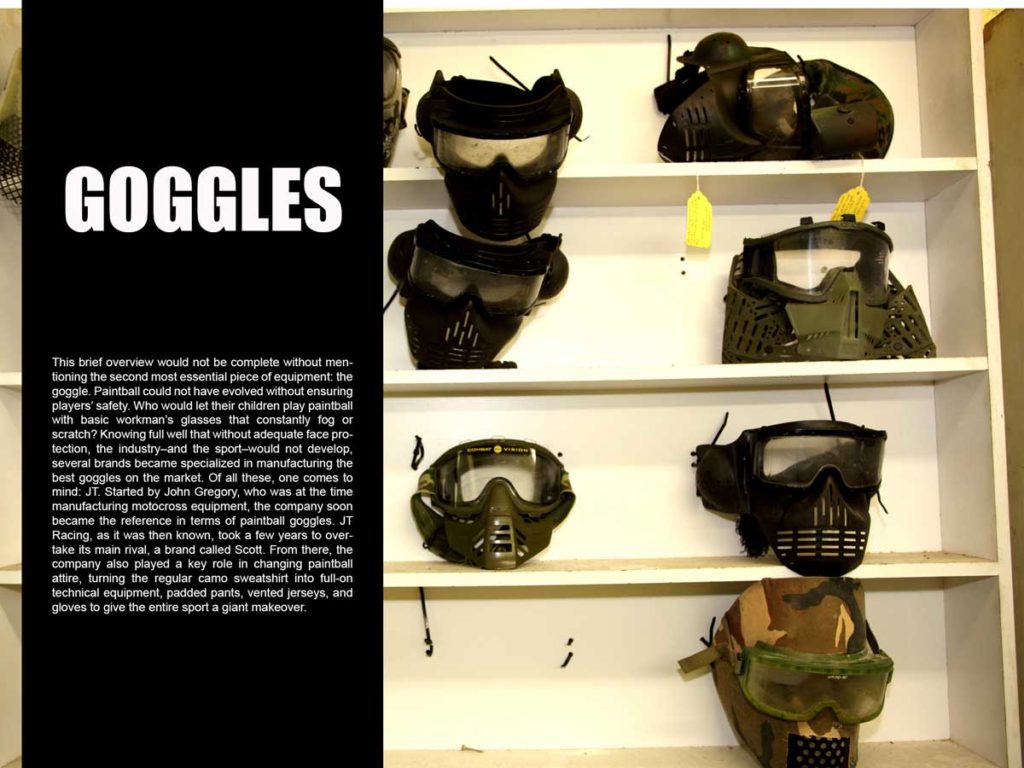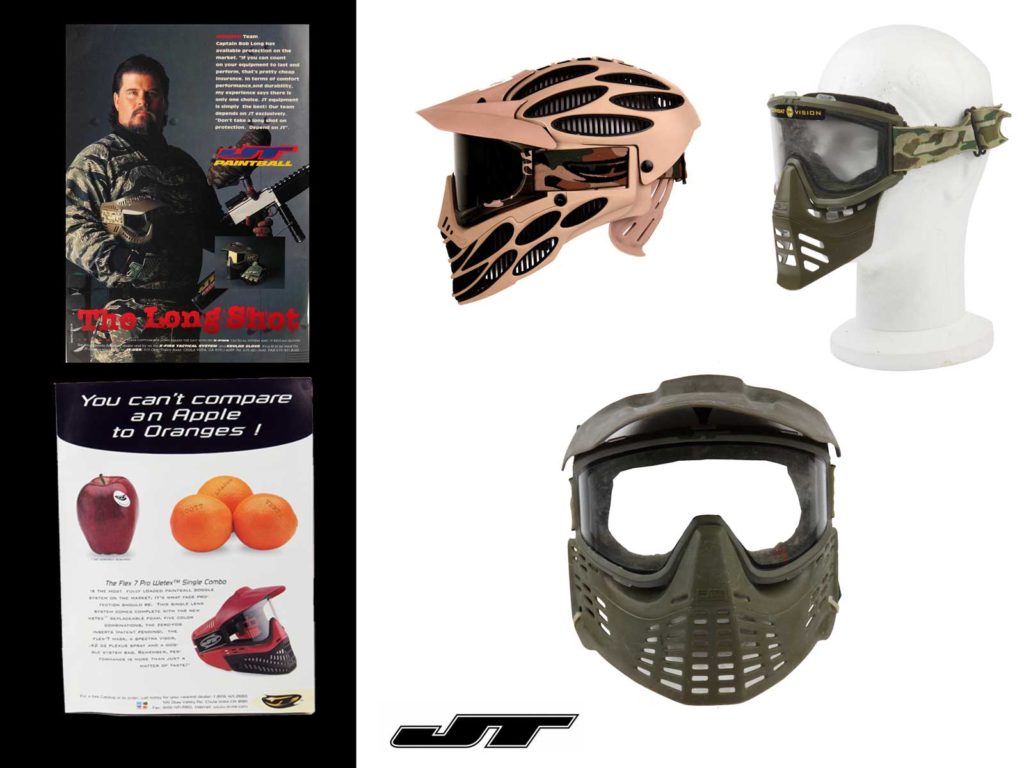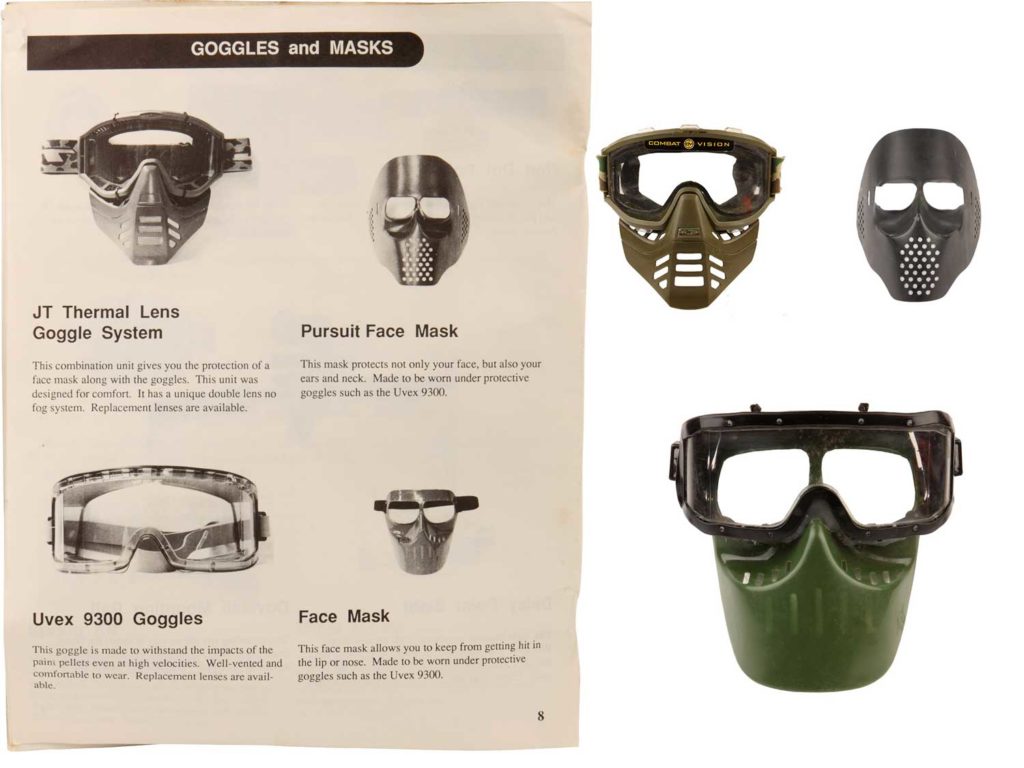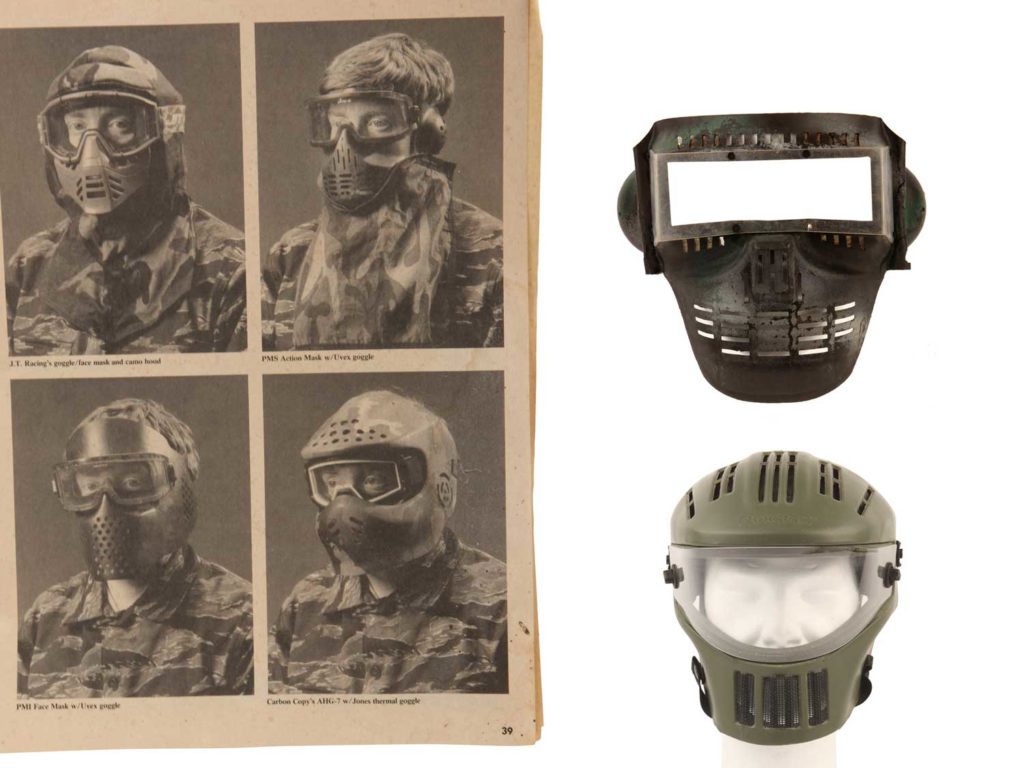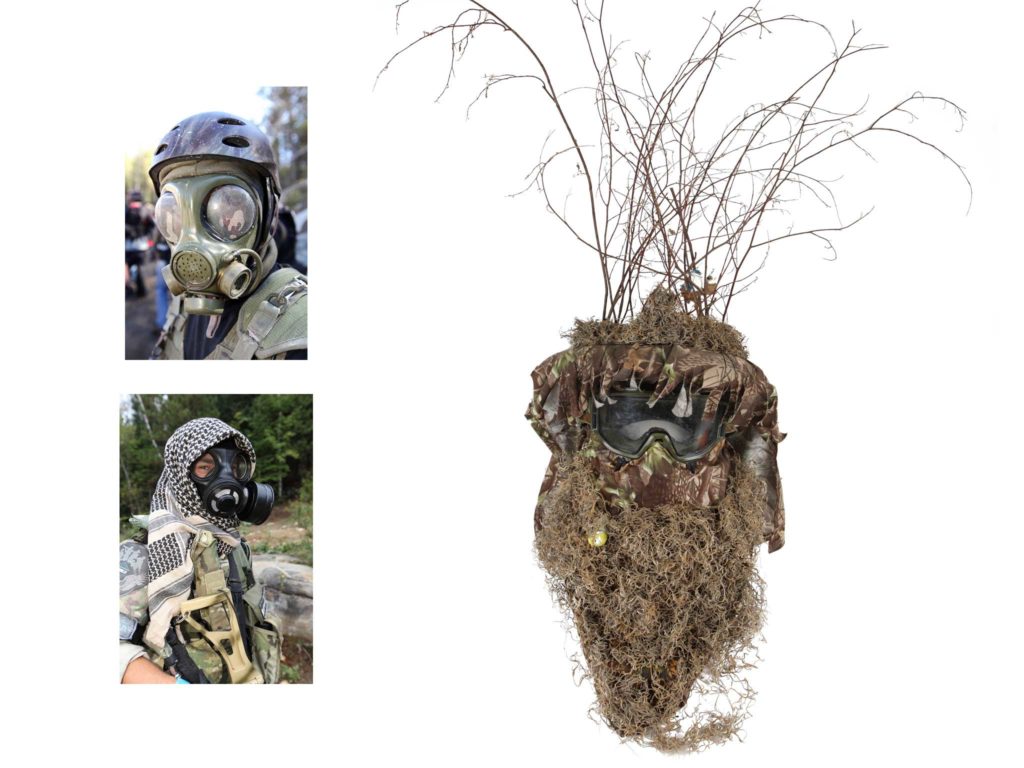

The creator
Who hasn’t dreamt of being a hero, of saving the world, or of leading their troops to victory ? Such scenarios abound in the expanding world of video games, but they remain virtual, on a screen, and are lived by proxy in a microchip universe. Yet there exists an alternative, an endless treasure-trove of adventure, where our minds harness both the power of imagination and reality, where our hearts start pounding in anticipation as our bodies are overwhelmed by adrenaline. Paintball lets you enter this universe, become the hunter–or the hunted–in situations that few experience. A possible threat and yet nothing more than child’s play.

Over the span of 25 years, and across the world, « paintball » has become synonymous with this exciting universe. This sport, which only barely existed in 1980, has joined the ranks of other adrénaline sports as ubiquitous as skateboarding, rollerblading, or surfing. Far gone is the time when telling people you played paintball always triggered the same response: « paint what » ?Sometimes they believed you were a pinball champion. You then had to start rambling for 30 minutes, explaining what the sport was about, to inevitably get the same response : « Right, you play war. » However, paintball has greatly evolved during the past decade, game formats have changed, the small screen has got involved, and above all, an increasing number of people now play paintball. During those years, the sport has managed to find its way into the media, often not glamorized- it’s true- but nevertheless always intriguing. First reserved for hobbyists, paintball has finally reached mass appeal. Today, when the word “paintball” is mentioned in conversation, the answer is always enthusiastic: “That’s awesome. My friend plays every weekend.” Paintball is now one of the world’s many ‘alternative’ sports.
Who would have thought that this survival game, which was born deep in the forests of the Eastern US, is now played in the bright lights of stadiums, and is the dedicated weekend activity of millions of people across the world. We aim to bring you a brief overview of the sport’s origins, its basic rules and its main personalities and key players.
For paintball to exist, the equipment, the actual ‘paint gun’,first had to be invented. The key to paintball is in its name : a ball full of paint. Without this little gelatin sphere, which bursts when it hits its target–leaving a small stain of paint– ;the game would have never been invented.
The small paint pellet needs to be fired from a marker (the common term for a ‘paint gun’), whatever its design. What would a paintball be without a marker, a pump marker, semi or fully automatic electropneumatic marker, or even a sling?
The legend goes that paintball came out of the woods, but few know that this is literally where it was first used, in the deep forest. Where trees are inaccessible. For many years, lumberjacks used paintballs to mark trees–the ones too hard to reach but destined to be cut down. They used the simplest and first type of marker ever invented. Few players today even know of its existence: the Nelspot. The Nelspot 707 was invented in 1970 by a company called Sheridan. Its caliber was already of 0.68, a number that would stay with paintball for most of its history. The marker wasn’t fancy and looked pretty much like a handgun. The gas used to propel the ball was stocked in 12 gram cartridges, the same used to carbonate water or make whipped cream. This cartridge gave the marker an autonomy of around 10 paintballs.
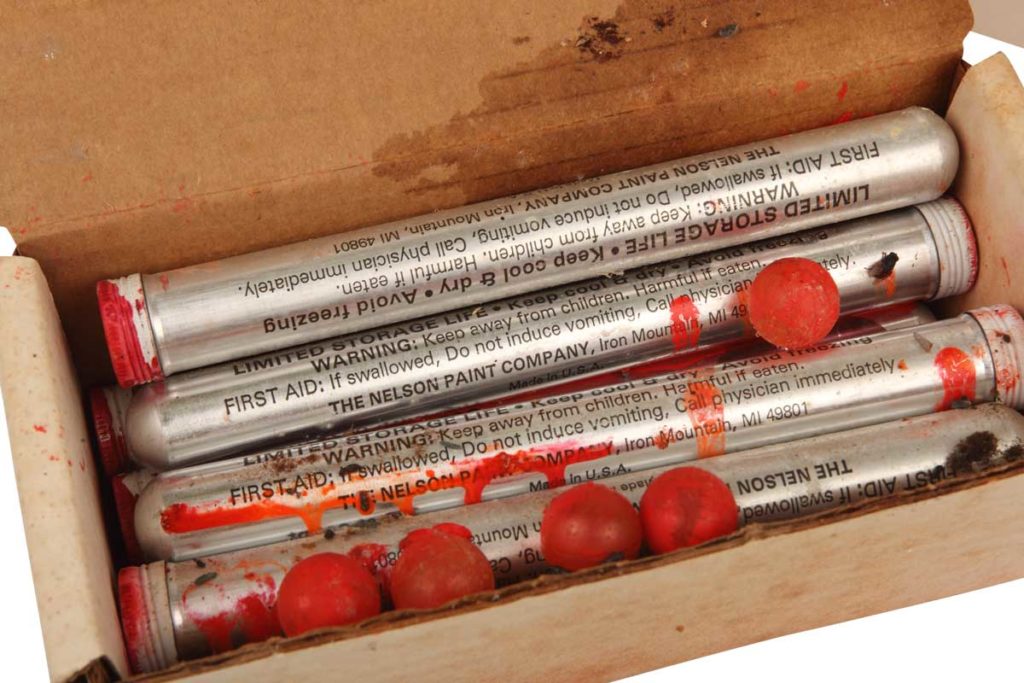
The Nelspot fired colored balls in gelatin shells. RP Scherer was the company entrusted with manufacturing these fragile and brittle projectiles. We say fragile for two reasons. The first is that they have to be protected from humidity and don’t fare well in either hot or cold temperatures. The second is that their shells have to be brittle enough to break on target, allowing the paint to spread in a fraction of a second. So yes, paintballs and markers already existed, but the sport… that still had to be invented.
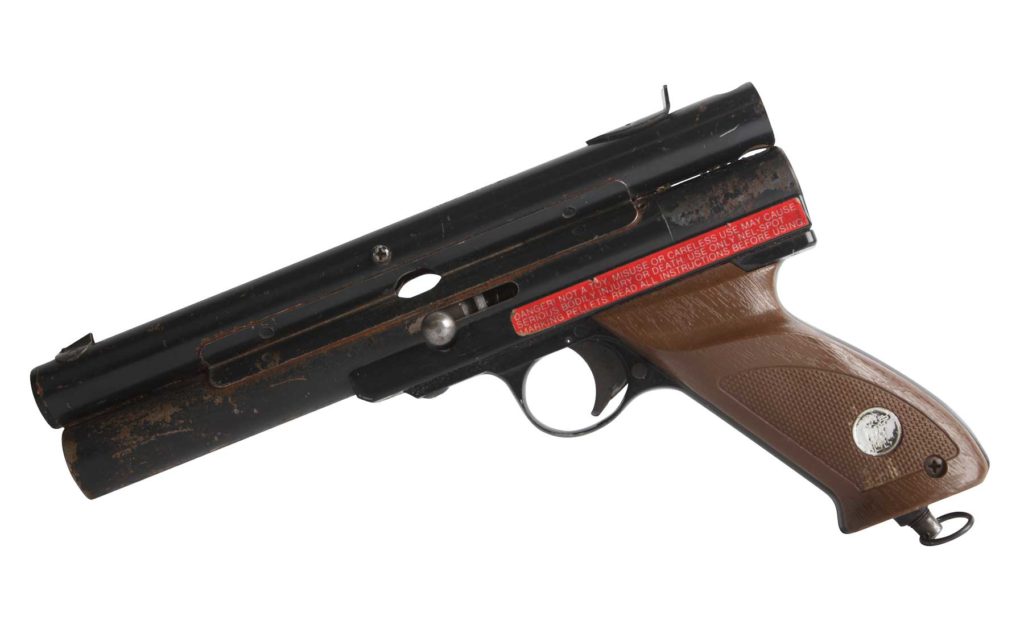
It came about as an idea amongst a group of friends. They wanted to find a way to test people’s ability to survive in extreme environments and situations. City slickers versus country boys. Long before reality TV shows like Survivor, people would be faced with the most extreme missions. This strange idea developed into a number of challenges, but it was on seeing a Nelspot 707 that the real game was born.
The creator and its creature
This invention could have remained buried in the woods if it hadn’t been for a couple of visionaries–kidults might be more appropriate–Charles Gaines and Bob Guersney, who were the first to fire a marker at each other in 1981.
They decided to organize the first game of paintball. The approach was very different from today’s game, played on turf fields hiding behind inflated obstacles. The word ‘stock class’ means little to today’s player, who navigates the vibrant industry that paintball has become. However back in 1981, there was no prior knowledge of the terrain, no inflatable obstacles, no fans… The organizers chose a forest as their first paintball field. Twelve men participated in this challenge. Who would survive? Who would be able to meet the objectives faster than the other? Each man was playing for himself, on some 100 acre-terrain, paintball marker in hand, and protected by a face mask that would give a modern-day paintball insurer a heart attack. Eliminating the opponents wasn’t the primary objective. Twelve flags were hung at various key locations on the area. Grabbing all 12 flags won the game. Paintball–the sport–was born.
It soon became clear for Guersney and Gaines that a game that drew on such raw instincts would be appealing. A sure way to fire up adrenaline in a few seconds. Hunt or be hunted, as if your life depended on it. Guersney brought this idea to market that same year. The national survival game was born. He fully committed himself to this project, which did not go unnoticed, and even garnered some media coverage. The buzz created around this game pushed him to further develop the game. From letters to frantic phone calls, the game was spreading through the entire country.
Yet paintball only began as an industry when Guersney first met Nelspot representatives. He managed to negotiate an exclusive distribution deal for paintball.



As in most new ventures, business was slow on the upstart, sales were stagnant and Guersney’s investors–despite them being first and foremost his friends–became restless. His main problem was a lack of visibility, there simply were not enough fields dedicated to the sport. How can you develop an activity without dedicated areas to practice it? He changed strategy. No paintball fields? Then let’s create fields. He offered a package deal to open fields across the country, a perfect beginner’s kit. The plan worked. Some 350 pioneers believed in the project, in the national survival game, and turned paintball into a full time job.
INTERVIEW OF BOB GUERNEY (By Facefull – Romain Manière)
SEARCHING FOR BOB
In May 1981, Bob Gursney, a sporting goods retailer, discovers a way to test people’s survival skills, Little did he know that this concept would change our lives forever.
In spring 2001, some twenty years later, paintball as in industry weighed an estimated 700 million dollars, with six billion paintballs sold each year. Players had left the woods for fan-filled organized stadiums. Manufacturers and distributors were spending millions in research and development to bring the latest equipment to thousands of players in all corners of the world practicing what had become a global sport.
It would be impossible to know weather the first twelve players entering the field on June 27, 1981, knew how many people would eventually follow them on this adventure. They were all friends of Bob, though. Doctors, journalist, lawyers mainly urban dwellers, ‘city slickers’, if you will. They were walking on 200 acres of unfamiliar terrain. It was an unsual game because it was part of a gambling weekend. They players were auctioned off, to see how much money could be raised, It was and individual game as well, Each player was given a Net-Spot 007 pistol. There were five flag stations, the object of the game was to collect flags from each station, and get to a home base where a judge would be waiting. The winner, so the legend goes, captured all flags without firing one shot. It is a clear today that this type of individual ‘capture the flag’ had different goal. Shooting other players was optional what Bob really had in mind was hiding, knowing when to strike, and seeing whether or not those ‘city slickers’ had it in them to complete in such a different and hostile environment. Not as hostile as the rainforest, mind you, but a definite precursor to the psychological and physical survival game didn’t vote other candidates off the field. The game was such a success that the spectators became bitter from not having a chance to play. It was seconds after, that Bob knew the impact his concept could have. He might even have turned to his friends and told them “This could be a business”. He had been in sales and marketing in the skiing industry for ever ten years. He decided to organize a second game. Three months later, Bob is boarding an airplane to Alabama, Looking out the window, he’s a little bit nervous, he spent a long time organizing this second game. “This thing will never work”. The words are still echoing in his head. He pulls out a piece of paper, and starts sketching rules. Two flag stations and then players a team. It sound right, transforms individuals survival game into a group effort, much like any other sport, he thinks, By the end of the second game, Bob had formed a corporation, with $20,000 as start up money. Half of
THE WINNER, SO THE LEGEND GOES, CAPTURED ALL FLAGS WITHOUT FIRING ONE SHOT.
It was spent on insurance, lawyers and a little equipment, the other half on salary and marketing strategies, They needed a name, and since the objective wasn’t to shoot someone, but to last, to survive, the National Survivor Game was founded in 1982 At one point, the company had 750 dealers and 20,0000 registered players.
Three years later, competition started developing and the trademark name ‘Survivor’ was being infringed upon Management tried to narrow the name down to NSG to get rid of the negative connotation.
This was mainly due to the hostile coverage of the television show’60 minutes’, where this game was compared to paramilitary training for terrorist groups. They apologized two weeks later, but the harm had already been done, like a foreshadowing of the endless problems and lawsuits that would plague Bob’s life for the following ten years. June 1985, Paintball’s the name, nobody’s playing the game. “This thing will never work”. The words keep echoing in his head. The paint guns are too expensive. They each cost $150, and you can’t play by yourself. Think fast. He got it. Just like in the skiing industry. How many skiers actually own their equipment? Does it stop them from hitting the slopes? Not a chance, they rent. Bob just needed fields, then he would rent out equipment to people who wanted to play. He might have turned around and headed back to the office. He might have realized that there was only #400 left in the NSG pocketbook. He might have been a gambler. Shotgun News magazine, target market, huge circulation $385 for a half page add. He picks up the phone and calls one of his friends. “You really have to get people into this game”. It is practically impossible to find the original add that was published but from memory, it was a drawing of a paintball player in camouflage, tucked between trees, hiding behind a boulder. Bob and written something like this. “You’re in 140 acres of wild terrain, headed for the blue flag. Suddenly, a shot. Splat! On the boulder in front of you. You take a dive, starting shooting…. You hit him!” Within four weeks, 2000 people called in. With this method, Bob had the advantage. He could speak to every single person who called in. The first was an older man from Northern Oklahoma. It took five or six phone calls. He loved the concept. For a $10,000 check, Bob convinced him that him and his son could work the fields together. For this man, it wasn’t so much for the money. He really wanted his son to do something. That weekend was long, as Bob waited by the phone, waiting for that call that would tell him that everything had gone wrong. Monday morning, Bob must have been at home. The phone rings, he shakes as he picks up the receiver. “You were right son! | made over $3000 this weekend! Could you get me more paintballs?” That man had become the first paintball dealer in the world. Bob might have ever smiled. It was a short smile, because a month later, Bob stopped answering the phone. Due to the toxic paintballs, landowners were calling him, threatening to sue because their field were destroyed, Some players might remember that it took eight good showers to wash off the paint. Bob wasn’t answering the phone because he was in the main paintball manufacturing offices, telling them that a new kind of paintball was necessary, something non-toxic and biodegradable. A type of paint that could be washed off, but not too easily. “This is never going to work” The general manager told Bob. He went to another one. Same answer. This became the first major struggle with the distributors, which stalled the entire industry. The weeks went by and the lawsuits kept crawling themselves in neat folders on Bob’s desk. “Mr. Guernsey, you’ve got a call on line one.” Bob picked up the phone. The savior was a company based in California.
ASK HIM YOURSELF
Name: Bob Guersney Age : 58
Occupation : Plastics manufacturer CEO
What did the first paintball actually look like ?
It hasn’t changed much since then. Off course, the components had different paint chemicals. They used them to mark trees.
How did you come across it ?
Through George Butler, the guy who produced the movie Pumping Iron. He called me one day and said that he had found guns that shot paint to mark trees and cattle. He told me that it was exactly what I needed.
What this what you had in mind ?
Absolutely. We were originally going to use .22 pistols. We would take the gunpowder out and use rubber pellets. He called me with this, and it looked way better.
Did you ever get to use .22 pistols ?
Never, our wives thought that we were nuts.
What was the original idea anyway ?
This was a game to see who would survive best in a hostile environment. The original concept differed from just shooting at each other. It was about survival skills. Who would be better at this game, city-dwellers or country-fold ? This was the original argument, we weren’t ever thinking about the guns. Some people are incapable of taking care of themselves in a different environments.
This is what you had in mind ?
The first game was different. We invited nine other friends to play with us from all over the US. We invited over a hundred People, but only nine said they would do it. After the first game, it was such an experience that everybody wanted to join in. We had a doctor, a movie producer, a salesperson, a forester, an investment banker and a writer. People from different backgrounds. It became evident that they all wanted to play. Unfortunately, there was no more time. I told them that the only way they would ever get a chance would be if it became a business.
You discovered this sport. We know that you quit this industry. If you were twenty years back, would you do it all again ?
No… to be honest, I wouldn’t go through it again. The last six years were terrible for me because I was under such attack by lawyers all over the country.
What kind of problems did you encounter ?
The basic problem was that players wouldn’t wear their safety equipment, would get hurt, and then blame us for it. It was always eye injuries. I’ll give you an example. One man from texas shot himself with a loaded paintgun. He took his safety goggles off, turned his marker around with his finger on the trigger. It was fully loaded. He blew his eye out. And then he sued me! He sued me out of the theory that if that I had never introduced and marketed his sport, he would still have an eyeball. There were many cases like that. Arguing, spending 24 hours a day on the phone with lawyers for six years is way too much for anyone. I’ve succeeded in many things in my life. This isn’t the only thing I’ve done.
Do you think that safety is still a major issue in this sport ?
Safety has always been important. We never had an accident that had to do with the failure of equipment, it was only the people… we never lost in court. But in America, when you win, you lose. You have to pay all the lawyers to be a winner. In Canada or Europe, things are different, if you win, others pay your legal fees.
What do you think about safety now ?
Paintball is one of those high kinetic energy sports. Safety never stops.
What do you think about tournaments in stadiums, about paintball as a professional spots ?
I think that paintball can be played in many different ways. It has been like that for a long time. The background is becoming a lot more sophisticated. I was specially impressed by that them park around Chicago. It’s fabulous and it’s the same game, with a different flavor.
Do you think paintball will reach the size of other stadium sports ?
No. To give you my person opinion, I don’t think that paintball would appeal to the mass viewing audience. People wouldn’t understand. It took hockey a long time to become what it is now. They had to change a lot of things about the arenas to make it more interesting for fans.
What could be done to change that ?
I think a lot of ideas have yet to come. Sports like these are like human beings. Once they are born, they evolve very quickly. Ever soccer and football are still being changed a little bit. Most sports become fully mature at 50, we’re only 20. A long way to go…
Do you still play ?
I have not played in seven years, but of 15 years, I played all over the world.
As a professional player ?
I was going to promote the sport. I used to travel more than 160 days a year. That’s how you build businesses and industries.
Four things you like and dislike ?
You can guess that it’s mainly the American justice system. I don’t like people who pretend to be business people but aren’t, the misuse of language in this country, and getting older. I truly like that fact that women can now compete on the same level as men in this country, in everything from business to sports. I like smoking and still being in good health, the fact that I’m out of the paintball industry, and my family and the people around me.
Some of these pioneers marked the sport’s history forever. Debra Dion Krischke worked as the main PR for the National Survival Game (NSG). She organized the famous International Amateur Open, and still owns a site called “Three River Paintball! Jerry Brown created the Orlando World Cup–paintball’s key international tournament and launched professional teams like Ground Zero or New York Extreme, a paintball media baron. Many others would follow in their footsteps.
Twenty-five years later, there are thousands of paintball fields on the planet. The sport is played on all continents, with more than 2500 in the US and hundreds in South America, Europe, Asia, and Africa.
Paintball was also marked as one of the most innovative and active industries in the world. Many entrepreneurs imposed their vision on this young sport. Companies and field owners transformed paintball. From the internationally-renowned fields–Hollywoods Sport, SC Village, or Bigfoot paintball–to the industry leaders like Dye, Tippmann, or WDP. All would change paintball for the better, making it more visible, more intense, and more appealing than ever.
PMI was the first company to start ordering large quantities of paintballs. Its CEOs Jeff Perlmutter and David Freeman had seen the sport’s great potential and knew full well that without paintballs, there was no sport. They started the distribution of paintball products in the fast-growing rental field market. Their main product was paintballs, to which they soon added a wide range of equipment. They brought out markers, of course, with the famous PGP, and later the PMI I, II, and III in semi – auto. They later released the Piranha marker and a wide range paintball-related equipment. They also were the first to structure the sport in paintball leagues. With these leagues came the first great paintball teams, the All Americans, Farside, the Florida Terminators. They moved paintball development abroad with, for instance, Paul Wilson and Steven Baldwin in the UK who hosted the famous Mayhem Master, for a long time the only major European paintball tournament.
With paintball’s fast expansion came new markets, and, with them, new brands. One company,Brass Eagle,did a lot for paintball by making paintball products available in large distribution outlets like Walmart. Founded in 1985 by Aldo Perrone, Brass Eagle knew that the sport could only grow if goods were easy to find and easy to purchase. It became the norm to find entire isles of paintball products in the sports section of large superstores, right between boating gear and fishing rods.
Markers have, since the first Nelspot 707, considerably improved. In the past 25 years, manufacturers have kept innovating with new systems and new designs; some successful, others less. The first real technical innovations came from a brand called Tippmann, which started manufacturing paintball markers in 1986. The company changed the sport entirely, introducing full auto and CO2 screw-in tanks. They were the first to significantly increase markers’ rate of fire. Since its inception, Tippmann has always been synonymous with innovation and reliability. This reputation was many years in the making, thanks to the création of some of the most famous markers in the sport’s history- the SL 68, but also the 98 model, the most reliable rental marker ever created.
Another key leader was Tom Kaye and a little company called Airgun Design, which also brought its share of patents to the table. With a few designs in hand, Kaye and his team started working on a semi – automatic marker that would be both reliable and fast: The Automag. The marker immediately garnered a large fan base and soon became the reference in terms of semi automatic technology. Its integrated regulator–which, as its name suggests, regulates incoming pressure–was a major development in the use of compressed air. The Automag regulator was perfectly adapted to this function, letting the marker operate with a high pressure tank. Kaye had found a high pressure cylinder already used in the industry and created a small revolution in paintball propulsing technology. Easy to use and providing greater autonomy, compressed air had all the right attributes to become the norm, though some paintball sites took time to make the costly change to their facilities. Airgun Design quickly conquered the UK market, collaborating with another company,The Kingman group, which marked the history of paintball, in both technology and on the field.
With its key product, the Spyder, the Kingman group made semi automatic markers accessible to the wider public. The company spread its web by marketing a simple but sturdy design (with its full metal body) at a good price. The Spyder was declined in a number of different versions, with a full accessory line. Kingman introduced an easy, cheap way to get into the sport, and then evolved overtime to higher-end markers. a recipe for success.
Smart Parts, a company launched in Pensylvannia by two brothers, Adam and William Gardner, was the first company to tackle the market of tournament paintball. The two brothers played in one of the top professional teams of the time, the All Americans, to which we’ll come back to later. Smart Parts started by marketing very technologically sound and precise equipment for the ever more demanding ranks of competitive players. The famous All American barrel topped all other barrels in the industry. The Shocker, whose design was dubbed ‘square’ at the time, was one of the most accurate markers on the market. The company’s motto– ‘equipment counts’ –had never held truer.
Dye is another success story for what started as a paintball barrel manufacturer and then went on to redefine high-end equipment. Its creator, Dave Youngblood–who had already made his mark with his team, the Ironmen–brought his personal genius to a fast-growing industry. Youngblood knew that surrounding himself with some of the most visible personalities of the sport would be beneficial. The brand, extremely active in competitive paintball, continues to sponsor some of the best teams in the sport and key players like Oliver Lang, the highest paid professional paintball player in the world.
Across the Atlantic, only a few European brands managed to make their mark on what had become a global market. Two UK brands marked the global industry. Paintball Eclipse revolutionized paintball technology by perfecting electronic grip frames. These were used to change anything, from the rate of fire to trigger responsiveness. The other brand WDP, with its rockstar attitude incarnates British pop paintball at its best. With a very aggressive marketing campaign, its main product, the Angel, was one of the most competitive markers of the time. The company remains as visionary today as it always has been.
Another brand, key to paintball’s success and its foray into stadiums, was a company called Adrenaline Games, which manufactured the inflatable obstacles that bring strategy to the game. The company let players leave the classic wooded terrain to create challenging scenarios on any open area.
Finaly, this brief overview would not be complete without mentioning the second most essential piece of equipment: the goggle. Paintball could not have evolved without ensuring players’ safety. Who would let their children play paintball with basic workman’s glasses that constantly fog or scratch? Knowing full well that without adequate face protection, the industry–and the sport–would not develop, several brands became specialized in manufacturing the best goggles on the market. Of all these, one comes to mind: JT. Started by John Gregory, who was at the time manufacturing motocross equipment, the company soon became the reference in terms of paintball goggles. JT Racing, as it was then known, took a few years to overtake its main rival, a brand called Scott. From there, the company also played a key role in changing paintball attire, turning the regular camo sweatshirt into full-on technical equipment, padded pants, vented jerseys, and gloves to give the entire sport a giant makeover.
With the development of the industry came the development of paintball media, from print magazines to websites, video feeds, and even TV shows, which all ensured the sport had its superstars. A huge number of players and paintball addicts the world over came together to creat an active community. Online, hundreds of thousands of people were strong-buzzing with the latest results, equipment reviews, and juicy gossip.
As for television, it was regarded for years as the sport’s holy grail. In fact, the sport changed entirely to adapt to TV’s ruthless format. New fields, new stadiums, and even a new game format–X-Ball–were all a part of it. X-Ball changed paintball from a one game adventure to ‘scoring points’ to win, and giving a two minute break between points to get ready for the next game, refill their markers, wipe the hits, etc.
From a simple hobby, paintball became–in a very short space of time–a highly competitive sport, with a strong industry, mind-boggling technology, and a full media spectrum. Groups of weekend players became teams, playing areas became paintball parks, and sunday games became tournament events, with cash prizes and all the glory that comes with it. These events then became structured and organized into leagues- some being international- to determine the best team in the world. But let’s not get ahead of ourselves, if paintball started in the woods, then that’s where the competition truly began.
THE BIRTH OF AN INDUSTRY
PAINTBALL
GUNS
PAINTBALL
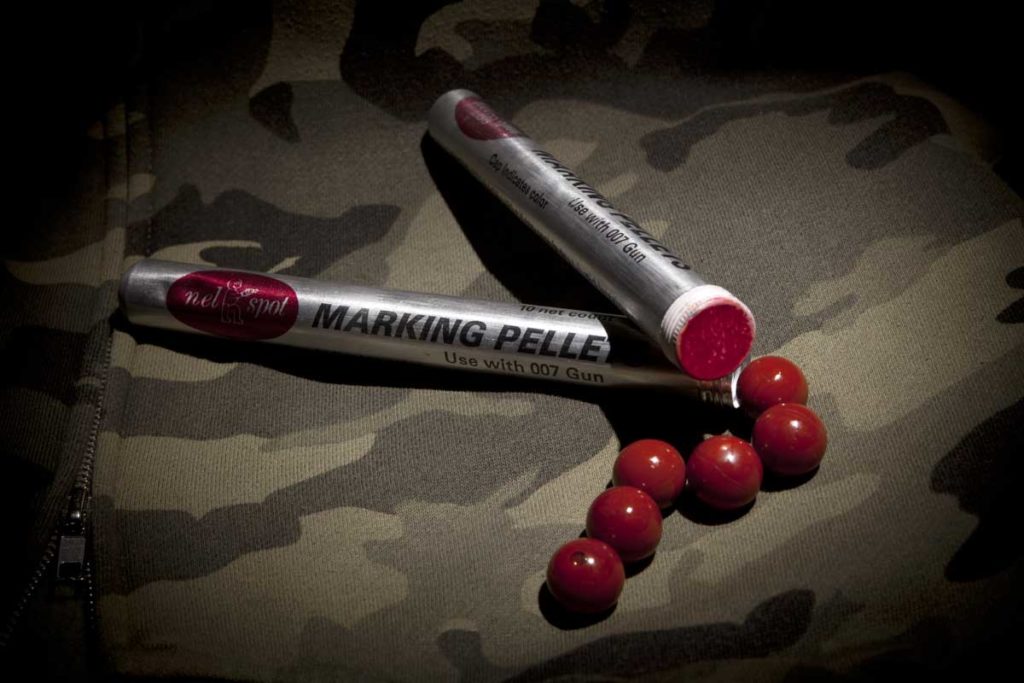

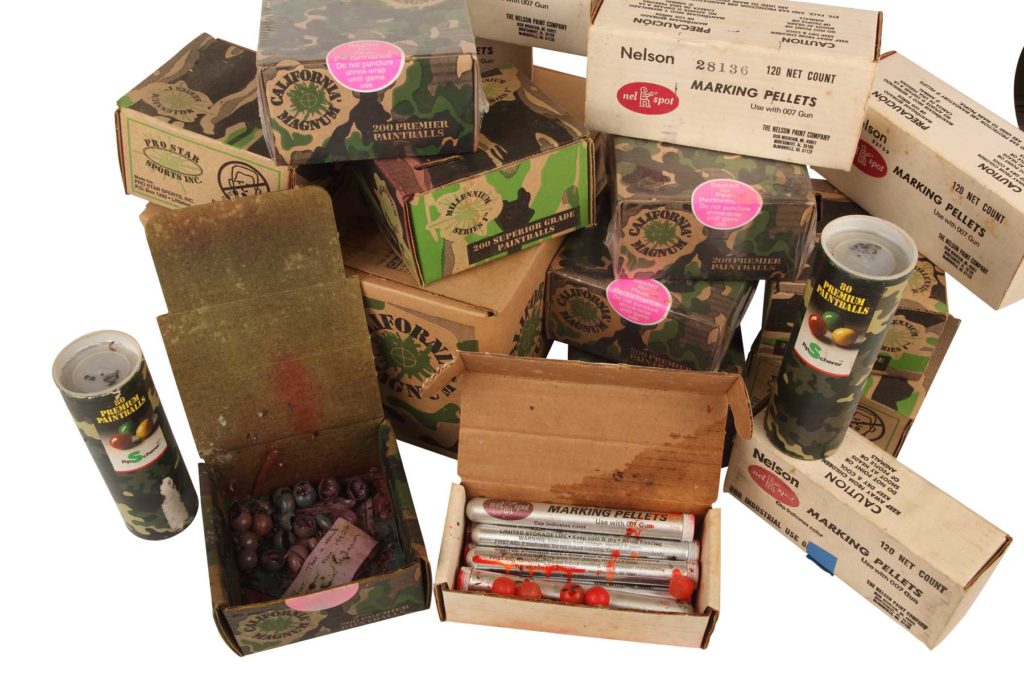



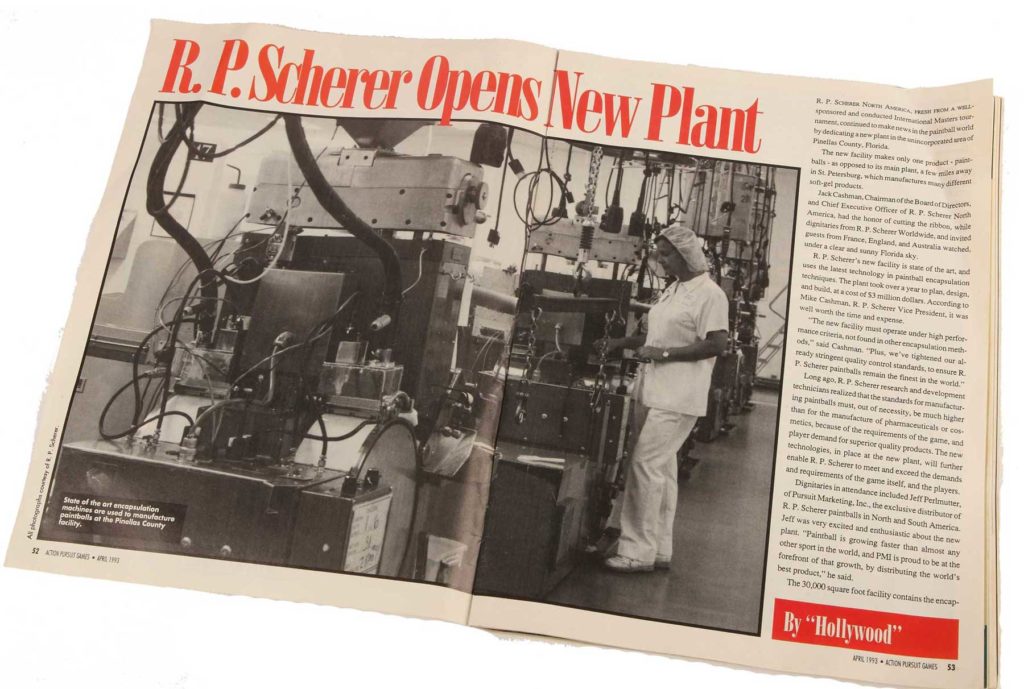
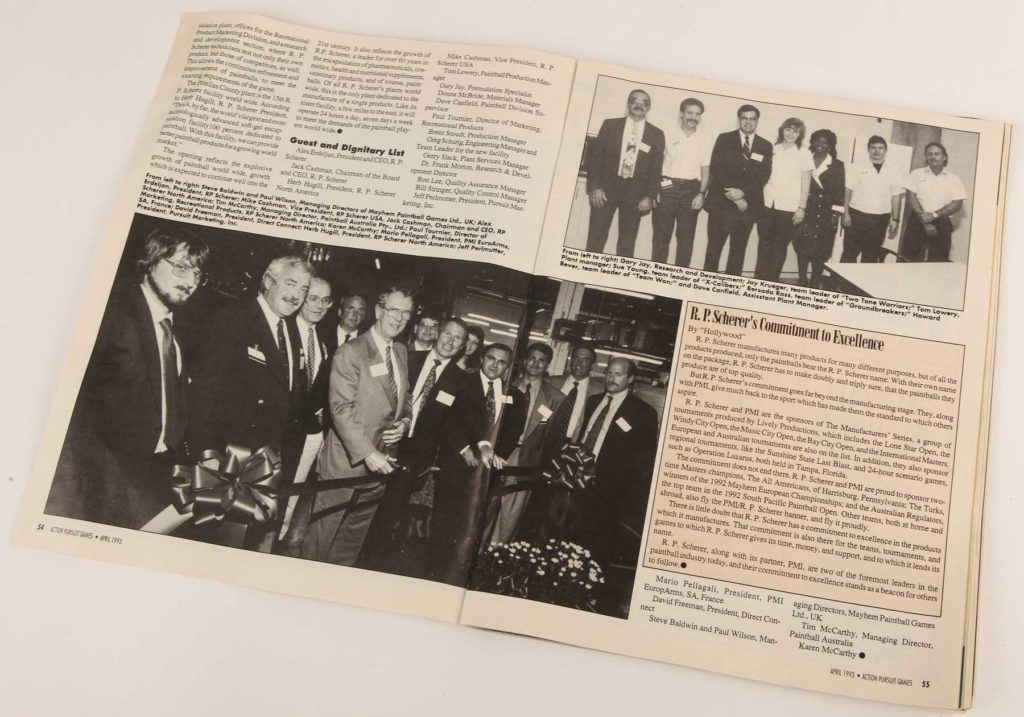
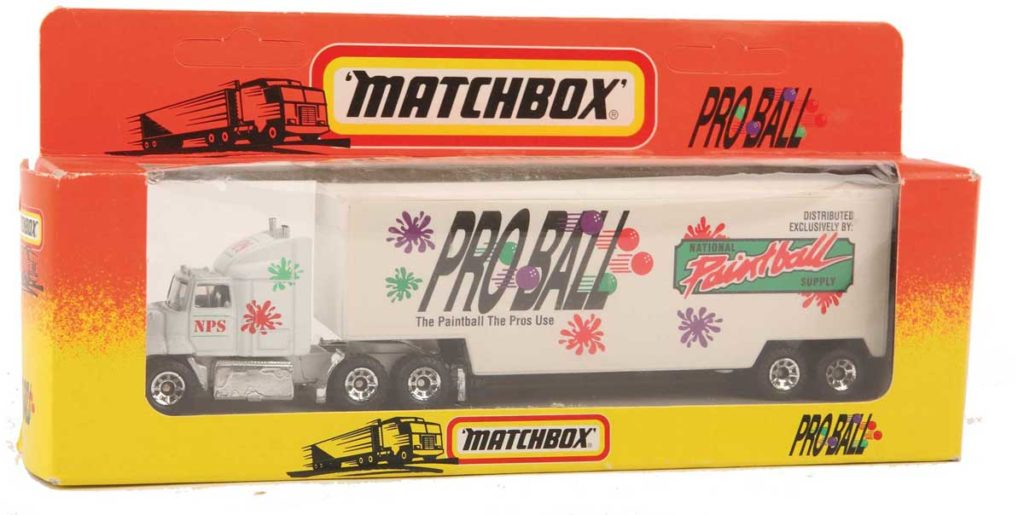




GOGGLES
